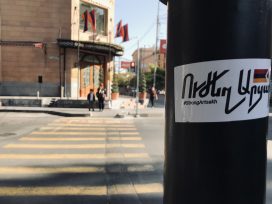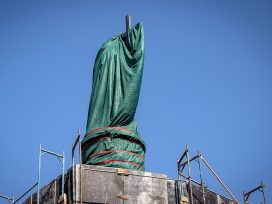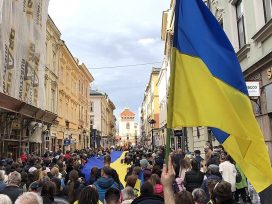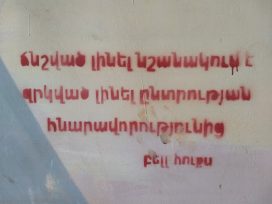The restaurant where we are having lunch is squeezed in between the main street and the vegetable market. It is still empty but the buffet is already lined up along the walls. One hundred Sri Lankan rupees, less than one euro, for rice and curry. The owner – we can call him Sajith – knows our interpreter; they exchange small talk in Sinhala. He asks who we are. We answer, through the interpreter, that we are researchers from Sweden studying the spread of organic farming in the area. He is interested, and asks if we know that there is a plant for the production of organic fertilizer nearby.
He explains that chemical fertilizers generally increase the crop, but at the same time create problems. For example, the quality of the crop is not as good. It is like a diabetic taking insulin: the medicine solves some problems but creates new ones at the same time. Previous generations managed using only organic farming. He doesn’t use organic products in his restaurant because he has to buy from larger suppliers and only rarely are they organic. However, each household should have it’s own organic garden. That kind of self-sufficiency is promoted in Mahinda Chintana, the action plan that Mahinda Rajapaksa proposed before he won the presidential election in 2005.
Another benefit of organic farming is that it is possible to use traditional seeds, Sanjith explains. Chemical fertilizers should preferably be used with hybrid seeds. The “refined” seeds give a bigger harvest, but they do not produce their own seeds. The farmers can no longer harvest their own seeds from the ripe crop but must buy new, expensive seeds every season.
Furthermore, the use of chemical fertilizers drains the earth, which in turn creates additional need for artificial fertilizers. Because the fertilizers are imported from foreign countries Sri Lanka is becoming more and more dependent on foreign interests, and among these interests are the multinational companies that produce the chemical pesticides that the farmers have become dependent upon. “They are like octopuses that suck the blood out of poor countries. They are like thieves who rob these countries.”

The interpreter translates and we take notes. We are not the only ones whose attention Sajith has caught – the staff and a couple of other lunch guests are also listening. “Another problem,” he continues, “is that the wealthy part of the world sells its surplus to the poorer parts of the world.” The rich world’s rice and wheat is forced upon the poor world, and puts local farmers out of business. We tell him we agree with him – the conditions for world trade in farming are seriously unfair. The global justice movement that grew strong in the rich world about ten years ago has often pointed this out. We ask him how this injustice is discussed in Sri Lanka. He answers that President Rajapaksa was the first to raise the issue. He says the president comes from a farmer’s family and knows what it means to farm the land.
Rajapaksa isn’t afraid of challenging the leaders of the rich world, multinational companies or NGOs. During the civil war, Sajith tells us, the rich world supported the LTTE – the so-called “Tamil Tigers” (Liberation Tigers of Tamil Eelam). The rich countries benefited from the war, through the arms trade for example, and therefore didn’t want the civil war to end. As a consequence, it was not possible to farm the land in some of the most fertile parts of Sri Lanka. Now that the war is over, he says these areas can become farmland again.
We have already finished our lunch and had a bottle each of the Sri Lankan Kik-cola. The sun is shining outside, but the windows just under the ceiling are narrow and only a thin streak of daylight reaches the dark restaurant. The old house is located close to the beach and is one of the few buildings along the waterfront that survived the tsunami in 2004.
Sajith claims that the tsunami in particular enabled NGOs from the rich world to become established in Sri Lanka. These organizations initially said they would work with tsunami-related aid, but increasingly came to help the LTTE. He thinks the way that Rajapaksa has dealt with the conflict with the LTTE – a conflict that has taken place in different forms since independence from the British in 1948 – was reasonable. The president first sought an armistice, but when that was violated by the LTTE sought support for the war from neighbouring countries, first India, then Pakistan and finally Iran – something that no other world-leader would dare to do. The previous president, who stood with one foot in Sri Lanka and one in the US, didn’t manage to stop the war. Even the UN was hypocritical: how can an organization that claims it wants to abolish child labour at the same time support the LTTE and their child soldiers?
The conversation moves smoothly between farming and food production on the one hand, and geopolitics and international relations on the other. Sajith’s reasoning runs from molecules to states and back again, with the issues of food and farming always present.
We come back for more lunchtime conversations in the course of our fieldwork. Among other things, we discuss the new superpower that for the past couple of years has become established in Sri Lanka. In 2007, the year that Sri Lanka received most of its aid from China, the two countries agreed to build South East Asia’s largest deep-water port in Hambantota. Sri Lanka’s second international airport and a cricket stadium are already under construction in the town. All projects are being built and financed by Chinese state-owned companies.
Sajith sees only benefits from this development. The two countries, he says, have a common history that goes back a long way. China represents a culture with an ancient heritage, something completely different from the greed and hypocrisy he thinks characterizes western culture.
As our conversations continue we come to understand his position and how he has ended up where he is. At the same time, his conclusion is rather demoralizing: Rajapaksa’s strength is that he has followed through on Mahinda Chintana without being held back either by internal minorities or external naysayers. These sentiments are particularly unpleasant in a country where opposition journalists are systematically murdered or disappear and where the government is suspected of having killed tens of thousands of civilian Tamils by the end of the war in 2009. Under Rajapaksa, the government of Sri Lanka has become even more authoritarian. Neither the story about this move towards authoritarianism, nor the one about the shift in power from West to East, can be told without references to the role that food and farming plays.
The new town
Sajith is not alone in describing how western aid agencies and NGOs were established in Sri Lanka after the tsunami. Naomi Klein describes a metaphorical “second tsunami” that has also meant a globalization led by western companies. The tsunami itself wiped out the houses and killed those who lived along the southern and eastern coast. It also became a pretext to create a buffer zone along the beaches. The survivors were not allowed to rebuild their old homes because the government wanted to prevent a similar tragedy. At the same time, according to Klein, tourist complexes were built along the beach.
This process was, in an eerie way, fully in line with the “shock therapy” programme that was launched in 2003, before the tsunami. The programme, “Regaining Sri Lanka”, which had the blessing of the World Bank, suggested that the country should open up its economy for private interests and at least release beach areas to enable the establishment of tourism. Hotels are more profitable and contribute more to economic growth than the fishing that previously took place on the beach. The “shock therapy” measures would also make loans from the World Bank and IMF available to Sri Lanka. The programme was, however, abandoned, because Sri Lanka – as Klein writes – was not interested in relocating poorer citizens so that Marriott or Hilton could build golf courses along the waterfront. Western capital comes in the form of hotels with rooms for US$800 per night. Such development is not unique to Sri Lanka, Klein argues: the same thing has happened in Thailand, the Maldives, Indonesia and India.

There are, however, not many traces of this supposed western capital tsunami in Hambantota. On the beach, in the middle of the bay that opens to the East, lies Peacock Beach Hotel. It was damaged during the tsunami but has been rebuilt and is now the only hotel in the town. The owner is Sri Lankan, and lives in the city of Ratnapura, known for its trade in gemstones. Fifty metres west on the beach are the ruins of another hotel that was destroyed by the tsunami. Rumour has it that Namal Rajapaksa, son of the president and local politician, has plans to refurbish and run the hotel himself. There are also rumours that the Rajapaksa family has bought the area around the cricket stadium with the intention of exploiting the area for future sports tourism.
In the village, the fishermen tell us about the problems of not living by the sea. Many Hambatota residents now live in the “new town” that has been built a couple of kilometres inland. There are buses between the new and old towns, but not early enough for the fishermen, who leave at four in the morning and come back just after dawn. One fisherman we talk to turns the argument on its head: “Why should the beach area be kept free, there are no hotels built there anyway?”
The tsunami wiped out areas and led to a movement of people, but the empty space has not been filled by western capital in line with neoliberal ideas. The new town in Hambantota was built primarily with foreign aid from Asian countries. The deep-water port is financed by China Exim Bank, whose lending, together with the China Development Bank, has recently exceeded that of the World Bank. The infrastructure projects in Hambantota are led by the construction firm China Harbour Engineering Company (CHEC), which is now constructing around 100 infrastructure projects in Asia, Africa and the Middle East. The capital that has swept in over Hambanota is not western, but rather Chinese – a fact wholly in line with developments outside Sri Lanka too.
For a researcher or author it is always temping to let theories of so called “mega trends” explain too much about any given situation. The dilemma of generalization: you cannot get an overview without at the same time ignoring important details. This can lead the writer to put misleading labels on places or people. Klein argues that western neoliberalism is shock introduced around the world, and places it like a grid along the whole Sri Lankan coast (and many parts of Asia). But these places, and the people who live there, are not allowed to object to Klein’s thesis. In the case of Hambantota, we can see how the shock doctrine theory is too coarse-grained. It leads us to believe that the US empire is winning victories – when in fact it is retreating before a new superpower. At the same time, it would be wrong to reduce Hambantota to an illustration of the well-known story about China’s return as a great power.
The political scientist Timothy Mitchell has been interested in these questions: How can researchers and authors write about specific places and people without losing sight of their particularity? Is it possible to describe places without writing another version of the story about modernization or capitalism? How can the writer resist the temptation – in study after study, place after place – to conclude that it is always the same old logic that shows its familiar, ugly face?
A related problem is the preference in the social sciences for “pure” and disciplined specific explanatory models. Mitchell takes the crisis that surfaced in Egypt in the early-1940s as an example. A geographer or rural sociologist would describe this period as dominated by Egyptian farming reforms: a story of how common sense and industry took over farming production. A political scientist or historian, on the other hand, would talk about the same period in terms of war and geopolitics. An epidemiologist or biologist would describe it from the perspective of the spread of the malaria. The challenge, according to Mitchell, lies in merging these stories and allowing them to intermesh, even if the main strands are radically different.
The most prominent cause of death in Egypt during the war years was the malaria parasite, according to Mitchell. It spread because war-related air traffic introduced a new kind of mosquito into the fauna. The imported mosquito species could reproduce in the still water of the reservoirs built during the modernization of the agricultural sector. The same modernization had made farmers dependent on artificial fertilizers containing ammonium nitrate, which is also used to make bombs. The increasing intensity of the war led to a shortage of fertilizers, which in turn caused a food crisis. The Egyptian crisis must therefore be understood in a way that pays equal attention to mosquitos, malaria parasites, ammonium nitrate molecules, states and people. Big concepts like “capitalism” must be placed in concrete situations where various entities collaborate in unexpected ways. The augmentation of capital then appears as a kind of parasite on chemical and biological matter.
Even modern Sri Lanka can be described as a story in which heterogeneous elements collaborate. President Rajapaksa came to power after an election campaign where candidates competed about who could promise the greatest subsidy on artificial fertilizers. But the same molecules that stimulate vegetation were, in the form of ammonium nitrate, a threat in the war against the LTTE; as a result, fertilizer was rationed in the northern parts of Sri Lanka. This is another reason why organic farming is much more prominent in Tamil-dominated areas.
A short chemistry lesson
Food production: the production of nitrogen compounds degradable by the human being. This definition originates from a text published in 1840 entitled Organic Chemistry in its Application to Agriculture and Physiology. The author was Justus von Leibig, one of the German chemists who, during the nineteenth and twentieth centuries, invented new ways of manipulating materials. To him, the difference between forestry and farming could be found at a chemical level: in the former the purpose is to create carbon compounds and in the latter to produce the nitrogen compounds that work as building blocks for living creatures.
The carbon atom and the nitrogen atom are both central to processes of life on earth but play different roles. Most of the living matter on earth consists of carbon atoms that act as the cohesive agent. In the biosphere it is coal that contributes to quantity, for example in the form of cellulose or starch. The nitrogen is not as bulky but can, in turn, contribute to quality in the matter in the biosphere. Special characteristics are required – the capacity to bind to other entities – which enable the existence of chlorophyll, of the nucleic acids in DNA, the amino acids that are the building blocks of acids and the enzymes that drive the chemical processes in the human being.
At the beginning of the nineteenth century, the correlation between life and nitrogen was well known. At that time, some chemists even thought that some materials could only be created by living organisms. Liebig was one of the many supporters of this “vitalistic principle”. This worldview was, however, challenged in 1828. Friedrich Wöhler – another German chemist – managed to create organic molecules from dead, artificially derived chemical ingredients. The material that Wöhler managed to synthesize was urea.
After that the notion of purely “organic” materials was abandoned. “Organic chemistry” was no longer the chemistry of life, but rather the chemistry of carbon compounds. The Wöhler synthesis did not, however, change the fact that nitrogen supply is essential to the expansion of life. Nitrogen deficiency is a common cause of limited growth: in farming, the result is yellow leaves, smaller crops, little return and low levels of protein. The maintenance of a human body requires a flow of nitrogen in the form of essential amino acids. Everyday an adult human being needs to replace 60 milligrams of nitrogen per kilogram of body weight; a growing child needs more than that.
The paradox of limited access to nitrogen is that we are surrounded by nitrogen. The compound makes up about four-fifths of the air around us. The problem is that the airborne nitrogen exists in a molecular form of two nitrogen atoms. This N2 molecule is resistant: the bond between the two atoms is strong. Nonetheless, the bond has to be broken down for the nitrogen to be able to become part of the biomass. Until the beginning of the twentieth century this could only be done by bacteria that have the capacity to split airborne N2 molecules, producing ammoniac in the process. The bacteria that live in the root system of leguminous plants replace the “fixed” nitrogen with carbohydrates full of the energy produced by the legume. This molecular exchange, which happens at a microscopic level, is a prime example of “mutual” symbiosis. None of the organisms act as a parasite on the others: both the legume and the bacteria benefit from their co-existence. The legume secures its access to vital nitrogen and the bacteria secure access to energy.
In 1909, another German chemist, Fritz Haber, managed to synthesize the fixation of nitrogen: artificial fertilization was invented. Over the course of the twentieth century, this newly-tamed chemical reaction was repeated, refined and drastically scaled up: in around 1890, 15 megatons of nitrogen was fixed for farming. A century later, almost eight times as much nitrogen was ploughed into the earth in the form of artificial fertilizers such as urea and ammonium nitrate. Forty per cent of the nitrogen that we eat today comes from artificial fertilizers, and this proportion is much higher in the rich parts of the world.
Haber’s discovery, which is now over 100 years old, is the first example of geo-engineering. It is also the oldest experiment in redirecting the flows of material and energy in plants. Energy is, after all, an important aspect in nitrogen flow: the Haber process requires a lot of energy and the large scale production of artificial fertilizers in the twentieth century has partially been made possible because of cheap access to fossil fuels. If you live in the rich part of the world, more than half the nitrogen in your body has been created through the burning of fossil fuels.
In modern food production, these two processes – Haber’s synthesis of ammoniac and the spread of this artificial fertilizer – are increasingly used. But an innovation does not spread “on its own”. While industrial production of fertilizers became a reality in 1913, it wasn’t until the mid-twentieth century that production stepped up. It was also at this time that the systematic and international lobbying for artificial fertilizers was established. The spread of hybrid seeds – the kind that Sajith was talking about – was part of the same movement. The campaign came to be called “the green revolution” and, despite being staged over 50 years ago, remains controversial.
Food and the state
The formation of the state of Sri Lanka, as it looks today, presupposes an influx of artificial fertilizers. It is not only animals and plants that benefit from the capacity of the nitrogen atom to bind together other entities: ammonium nitrate and urea consolidate a constellation of power dominated by the Rajapaksa family. The same molecules affect the unity of the dominant ethnic group. But the nitrogen-based compounds can also constitute a threat for these united entities. Another type of “compound”, the Tamil Tigers, developed tactics to use the chemical properties of the fertilizer against the government. The reactivity of ammonium nitrate contains the possibility of uniting a people and of tearing apart the state.
States can be seen as power structures that seek to control the energies held in the chemical and biological materials. This also holds true for the port in Hambantota. It plays an important geopolitical role in securing the state formation of China. Of course, it isn’t only the nitrogen atom that is vital for the processes of life on earth; the carbon atom plays a different but equally essential role. The port of Hambantota exists to secure the ship-borne flow of ancient organic material, from the resources in the deserts in the Middle East, to the energy consuming gadgets that drive the Chinese economic miracle. China scholars sometimes point to the secret agreement that the one-party state has with its rich middle class, whereby economic growth is chosen over political reforms. This pact is secure as long as oil-driven growth is guaranteed.
Here, the state is perceived as a form of life in parity with plants and animals. There are many different versions of this idea. The philosopher Alfred North Whitehead, who suggested that all thinking in the world was a kind of sociology, promoted one particular kind. He suggested that everything is a society: a solar system is a society of celestial bodies, a crystal is a society of minerals. The social aspect of the solar system has to do with celestial mechanics; the social aspect of crystals has to do with their chemical bonds and regular glitter structures. Some societies are composed of human beings and these are always embedded in non-human societies – solar systems and crystals for example. Whitehead argued that even societies other than those that refer to human interactions could be referred to as living societies. A crystal is not a living society, because it can remain in its ordered condition without help from its surroundings. A living society, for example a body or state, presupposes that something is always stolen from its surroundings. This is fully in line with the complexity theory that became popular towards the end of the twentieth century. Living entities can only fool the second law of thermodynamics – the universal drive towards entropy, disorder – if they are provided with a constant flow of material and energy. All living things need, in an abstract sense, some kind of food.
The expression “the state as a form of life” was coined about 100 years ago by the Swedish political scientist Rudolf Kjellén. During the autumn semester of 1908, he held a series of popular scientific public lectures in Gothenburg with the title “The state as a form of life: Outlines of an empirical knowledge of states”. In his appeal for this “empirical knowledge of states” he turned against the then dominant “liberal” view of political science. The discipline was, according to Kjellén, a kind of “science of constitutions” where states were described in terms such as republic and monarchy. Kjellén argued that this focus on “external measures” rather than “inner life” led political scientists in the wrong direction. Was it not clear, he asked, that the state of the twentieth century had become something more – something more substantial – than merely a legal construct? The state was no longer an empty container that “only preserved the right while the individual dealt with the progress”. No, the state of the early-twentieth century is “itself a progressive force, and of them all the incomparably largest”. In other words, states do something:
These states speak and act, sit together in congresses or fight in battlefields, are jealous and hate or sympathize with each other, tempt and flee each other, help and harm each other, just as any other living creatures in a society. Each and everyone behaves like an individual, with its particular character, its interests, its behaviour and emotions.
Kjellén’s work could thus be seen as an exploration of the ontology of states that determines that these “are reasonable creatures – just like human beings”. The state is both a living and emotional entity. This living object is the “object of political science”. Political science, therefore, has to be “deeply convinced that in its objectives, the question of super-individual life is just as real as the individual, only comparably larger and more powerful in its development”. From this perspective, States become a kind of lifeform that survives our individual lives:
Governments change, generations change, but the foundational forces remain the same […] they are objective realities external to and above individuals – at the same time as within them – and in that way they are also subject to the foundational laws of life.
These foundational laws of life – for example that all living creatures need food – are thus central when we try to understand interstate power games. “Biopolitics” is the term Kjellén uses to denote his approach: because they are alive, states have to become subject to “a biopolitical examination that seeks to explore laws for their development”.
Kjellén is also said to be the originator of the concept of “geopolitics”, which is used today to describe interstate power games in relation to territories, energy and the security of states. The twentieth century, of which Kjellén saw only the beginning, developed into a Cold War where geopolitics was discussed in relation to high technology; atomic bombs and star wars. A decade into the twenty-first century, geopolitics has once again been linked to what we can call the “fundamental elements of the state”: access to food and energy. Remember the restaurant-owner Sajith’s clever merging of farming and food production on the one hand and geopolitics and international relations on the other. Food production not only affects the lives of individuals, but also the survival of “super individual” states.
It is still unclear whether the motivations behind China’s investments in the Hambantota area are commercial or for security reasons. Whichever it is we can now talk of a new kind of Chinese “soft power” signified by the existence of the new port. Almost everyone we have met during our fieldwork has had to relate to the Chinese investments and many associate them with hopes of improvements and welfare. The US writer Robert Kaplan sees China’s Hambantota project as indicative of the change in power in the East. One chapter in the book Monsoon tells of Hambantota’s place in the string of geo-strategic ports. He concludes: “Our foreign aid emphasis is on democracy, human rights and civil society; theirs is on massive infrastructure projects and authority, civil or not.” Here Kaplan engages in a certain level of smugness, which he, being American, cannot afford – and one which Sajith, who happily points to the hypocrisy of the West and their supposed good intentions, is unlikely to agree with. After its “war against terrorism”, the West cannot credibly criticize the Sri Lankans for their war against the “LTTE terrorists”.
When we arrive in Hambantota for our last visit in November 2011, the port has not yet started to deliver any of the promised rewards. Construction has been delayed; they have found a rock nine meters deep in the inlet of the port. Some residents in Colombo have started to grumble about the cost of the project; food and energy prices have increased, so why waste money on a port? In Hambantota, the faith in the project is stronger. The discussion resembles that in Orwell’s Animal Farm: Napoleon says food today, Snowball promises welfare tomorrow. In the Orwellian fable, the temptation of the wind turbines wins and captures everyone’s hopes for the future. The port in Hambantota has the same effect: it will secure people’s livelihoods and extract nutrition from the flow of resources that, at the moment, floats past in super-tankers a few miles out to sea.
We cannot, then, view these infrastructure projects as dead projection surfaces for human hopes. The wind turbine and the deep-sea port are apparatuses to exploit the world’s deposits of chemical and biological forces, aimed to serve both people and states. They represent the fact that living societies continuously steal from surrounding societies. Life is robbery, and the loot is what we call food.










